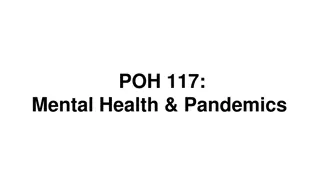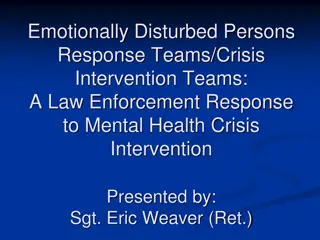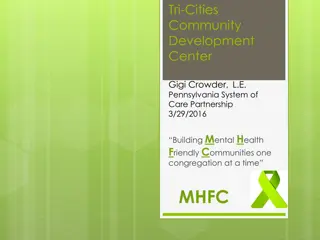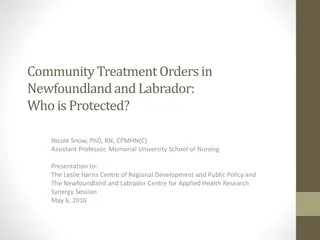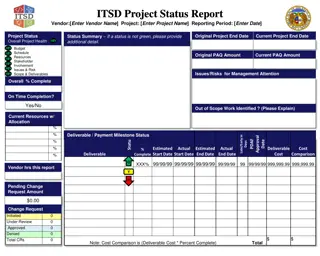
Understanding Mental Status Examination (MSE) Procedure in Psychiatry
Explore the purpose and significance of the Mental Status Examination (MSE) in evaluating the mental and emotional functioning of patients in psychiatric assessments. Learn about its theoretical foundations, application, and key domains that provide essential insights for diagnosis and treatment planning.
Download Presentation

Please find below an Image/Link to download the presentation.
The content on the website is provided AS IS for your information and personal use only. It may not be sold, licensed, or shared on other websites without obtaining consent from the author. If you encounter any issues during the download, it is possible that the publisher has removed the file from their server.
You are allowed to download the files provided on this website for personal or commercial use, subject to the condition that they are used lawfully. All files are the property of their respective owners.
The content on the website is provided AS IS for your information and personal use only. It may not be sold, licensed, or shared on other websites without obtaining consent from the author.
E N D
Presentation Transcript
StudyMafia.Org Mental Status Examination(MSE) Submitted To: Studymafia.org Studymafia.org Submitted By:
Table Contents Definition Introduction Theoretical foundations Application of MSE Domains of MSE Conclusion 2
Definition The Mental Status Examination (MSE) is a standardized procedure used to evaluate the client s mental and emotional functioning at the time the client is seen by the mental health professional. It involves a precise series of observations as well as some specific questions. 3
Introduction The purpose of the MSE is to obtain a comprehensive cross-sectional description of the patient's mental state, which, when combined with the biographical and historical information of the psychiatric history, allows the clinician to make an accurate diagnosis and formulation, which are required for coherent treatment planning. 4
Introduction Appearance, behavior, and attitude Characteristics of speech Affect and mood Thought content, thought form, and concentration Orientation Memory General intellectual level Insight and judgement 5
Theoretical foundations The MSE derives from an approach to psychiatry known as descriptive psychopathology or descriptive phenomenology, which developed from the work of the philosopher and psychiatrist Karl Jaspers. From Jaspers' perspective it was assumed that the only way to comprehend a patient's experience is through his or her own description (through an approach of empathic and non-theoretical enquiry). 7
Application of MSE It is a key part of the initial psychiatric assessment in an outpatient or psychiatric hospital setting. It is a systematic collection of data based on observation of the patient's behavior while the patient is in the clinician's view during the interview. The purpose is to obtain evidence of symptoms and signs of mental disorders, including danger to self and others, that are present at the time of the interview. The information obtained in the MSE is used, together with the biographical and social information of the psychiatric history, to generate a diagnosis, a psychiatric formulation and a treatment plan. 8
Domains of MSE Appearance: Clinicians assess the physical aspects such as the appearance of a patient, including apparent age, height, weight, and manner of dress and grooming. Colorful or bizarre clothing might suggest mania, while unkempt, dirty clothes mightsuggest schizophrenia or depression. If the patient appears much older than his or her chronological age this can suggest chronic poor self- care or ill-health. 9
Domains of MSE Attitude: Attitude, also known as rapport or cooperation,refers to the patient's approach to the interview process and the quality of information obtained during the assessment. 10
Domains of MSE Behavior: Abnormalities of behavior, also called abnormalities of activity,[19] include observations of specific abnormal movements, as well as more general observations of the patient's level of activity and arousal, and observations of the patient's eye contact and gait. Abnormal movements, Forexample choreiform, athetoid or choreoathetoid m ovements may indicate a neurological disorder. 11
Domains of MSE Mood and affect: The distinction between mood and affect in the MSE is subject to some disagreement. For example, Trzepacz and Baker (1993)describe affect as "the external and dynamic manifestations of a person's internal emotional state" and mood as "a person's predominant internal state at any one time", whereas Sims (1995) refers to affect as "differentiated specific feelings" and mood as "a more prolonged state or disposition". 12
Domains of MSE Speech: The patient's speech is assessed by observing the patient's spontaneous speech, and also by using structured tests of specific language functions. This heading is concerned with the production of speech rather than the content of speech, which is addressed under thought process and thought content 13
Domains of MSE Thought process: The paintings of the outsider artist Adolf W lfli could be seen as a visual representation of formal thought disorder.[citation needed] Thought process in the MSE refers to the quantity, tempo (rate of flow) and form (or logical coherence) of thought. Thought process cannot be directly observed but can only be described by the patient, or inferred from a patient's speech. Form of the thought is captured in this category. One should describe the thought from as thought directed A B(normal) vs formal thought disorders. 14
Domains of MSE Delusions: A delusion has three essential qualities: it can be defined as "a false, unshakeable idea or belief which is out of keeping with the patient's educational, cultural and social background held with extraordinary conviction and subjective certainty and is a core feature of psychotic disorders. For instance an alliance to a particular political party, or sports team would not be considered a delusion in some societies. 15
Conclusion The mental status exam should include the general awareness and responsiveness of the patient. Additionally, one may also include the orientation, intelligence, memory, judgment, and thought process of the patient. At the same time, the patient's behavior and mood should undergo assessment 16
References Google.com Wikipedia.org Studymafia.org Slidespanda.com
Thanks To StudyMafia.org




